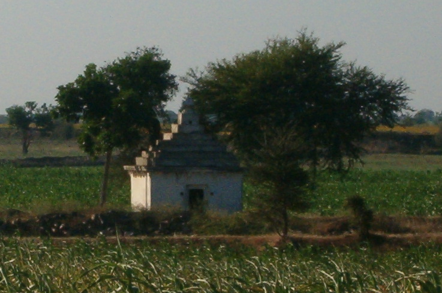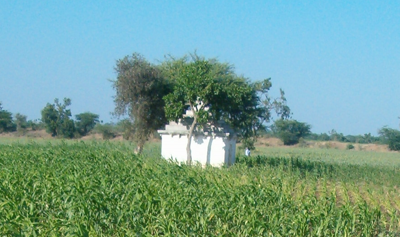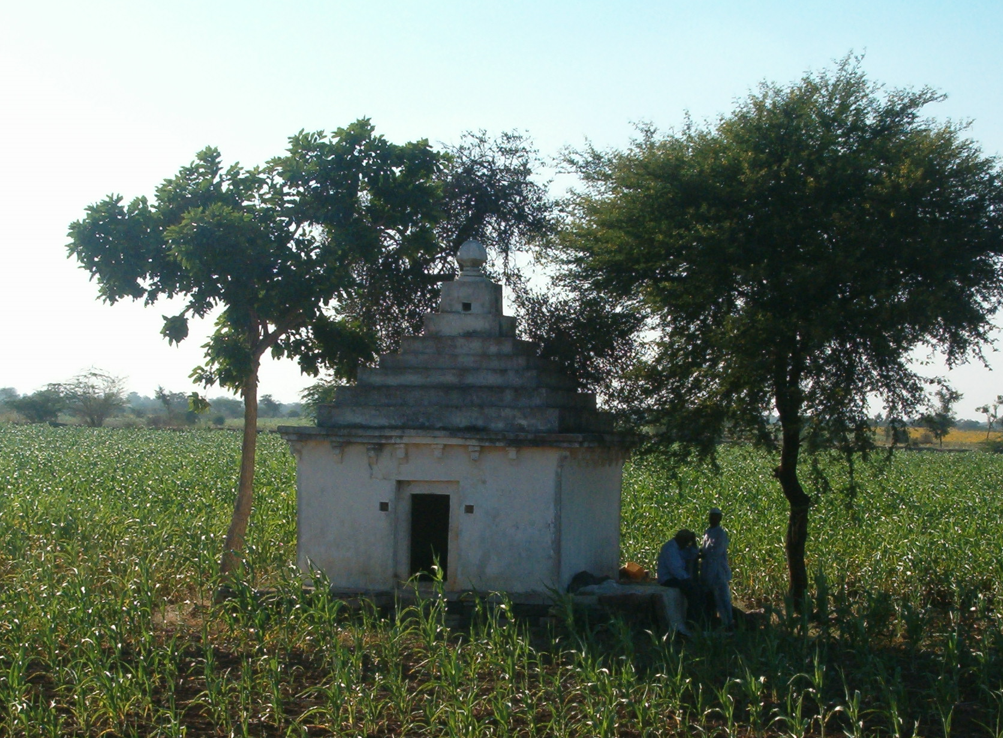* ॐ गजकर्णकाय नमः | ಓಂ ಗಜಕರ್ಣಕಾಯ ನಮಃ | Ōṁ Gajakarṇakāya namaḥ *
An epic story from Bhāratavarṣa (भारतवर्ष/ಭಾರತವರ್ಷ)
Gudiholā an epic story
Once upon time, in the quaint village of Hulamenchi, nestled within Basavana Bagewadi Taluka in Karnataka state, India, a group of young men gathered at the Punchayatha Katti, their village's communal meeting place. Their lively banter was interrupted by the unexpected appearance of an extraordinary bull. Unlike any they had ever seen, this bull was a vision of strength and beauty, its presence both captivating and unsettling.Intrigued by this magnificent and exotic eye-catching bull, the young men quickly realized it was a stranger in their midst. Driven by a mix of curiosity and a desire for adventure, they embarked on a thrilling chase. The bull, however, proved to be a formidable opponent, its movements swift and unpredictable, leading the young men on a wild goose chase through the surrounding fields.After a chase that stretched for kilometers, the bull abruptly vanished at the edge of a nearby farm. Disconcerted and slightly shaken, the young men halted their pursuit. This farm, now known as Gudihola Farms, would forever be linked to the memory of the mysterious bull.News of the encounter spread like wildfire through the villages of Hulamenchi and Byakod. However, as time passed, the incident faded into local folklore. Then, tragedy struck. While plowing his fields at the very spot where the bull had vanished, a farmer's bullock suddenly collapsed and died.Concerned by this eerie coincidence, the Sajjan family, owners of the farm, sought the counsel of spiritual experts. They were advised to bury the bullock at the exact location and construct a temple dedicated to Lord Basava, the sacred bull of Lord Shiva.The villagers, heeding the advice, meticulously built a small temple adorned with vibrant red and blue-grey stones. They dedicated themselves to worshipping at the temple on Amasya (no moon day) and during significant Hindu festivals like Charaga-challuvadu/Mannu-Yattina Amayasye.Over the decades, the temple gradually fell into disrepair, its beauty marred by neglect and decay. Rumors began to circulate of hidden treasures guarded by snakes, particularly the venomous cobra. These rumors attracted treasure seekers who, in their quest for riches, further damaged the sacred site.In 1986, the Sajjan family, led by Siddamallapa and his son Somashekhar, undertook the arduous task of restoring the temple to its former glory.While no written records document the events of that fateful chase, the story has been passed down through generations within the Sajjan family and among the villagers of Hulamenchi and Byakod. It serves as a reminder of the enduring power of folklore and the mysterious forces that shape our world.May the blessings of Lord Basava (Lord Shiva’s bull called Nandi as well) be upon all who visit this sacred site and remember the legend of the enigmatic bull.ಒಂದಾನೊಂದು ಕಾಲದಲ್ಲಿ, ಬಸವನ ಬಾಗೇವಾಡಿ ತಾಲೂಕಿನ ಹುಲಮೆಂಚಿ ಎಂಬ ಹಳ್ಳಿಯಲ್ಲಿ, ಯುವಕರ ಗುಂಪು ಪಂಚಾಯತ್ ಕಟ್ಟಿಯಲ್ಲಿ ಒಟ್ಟುಗೂಡಿದ್ದರು. ಅವರು ಹರಟೆ ಮಾಡುತ್ತಿರುವಾಗ, ಅಸಾಮಾನ್ಯ ಎತ್ತಿಗೆಯು ಹಾದುಹೋಗುವುದನ್ನು ಗಮನಿಸಿದರು. ಈ ಎತ್ತು ಬಹಳಷ್ಟು ಆಕರ್ಷಕವಾಗಿತ್ತು, ಧೈರ್ಯಶಾಲಿಯಾಗಿತ್ತು ಮತ್ತು ಅವರು ಮೊದಲು ನೋಡಿದ ಯಾವುದೇ ಇತರ ಎತ್ತಿಗೆಗಿಂತ ಭಿನ್ನವಾಗಿತ್ತು. ಅದರ ಮೂಲದ ಬಗ್ಗೆ ಕುತೂಹಲದಿಂದ, ಅದು ಅವರ ಹಳ್ಳಿಯಿಂದ ಬಂದಿಲ್ಲ ಎಂದು ಅವರು ಬೇಗನೆ ಅರಿತುಕೊಂಡರು.ಎತ್ತಿಗೆಯನ್ನು ಹಿಡಿದು ಕಟ್ಟಲು ನಿರ್ಧರಿಸಿದ ಯುವಕರು ಅದನ್ನು ಬೆನ್ನಟ್ಟಲು ಹೊರಟರು. ಆದಾಗ್ಯೂ, ಎತ್ತಿಗೆ ವೇಗವಾಗಿತ್ತು ಮತ್ತು ಧೈರ್ಯಶಾಲಿಯಾಗಿತ್ತು, ಅದನ್ನು ಹಿಡಿಯುವ ಅವರ ಪ್ರಯತ್ನಗಳನ್ನು ತಪ್ಪಿಸಿತು. ಬೆನ್ನಟ್ಟುವಿಕೆಯು ಹಲವಾರು ಕಿಲೋಮೀಟರ್ಗಳವರೆಗೆ ಮುಂದುವರೆಯಿತು, ಎತ್ತಿಗೆ ನಿಗೂಢವಾಗಿ ಕಣ್ಮರೆಯಾಗಿ ಕೆಲವು ಅಡಿ ದೂರದಲ್ಲಿ ಮತ್ತೆ ಕಾಣಿಸಿಕೊಂಡಿತು, ಇದು ಯುವಕರನ್ನು ಹೆದರಿಕೆ ಬರಲಾರಂಭಿಸಿತು. ಅವರ ಕುತೂಹಲವು ಅವರನ್ನು ಬೆನ್ನಟ್ಟುವಿಕೆಯನ್ನು ಮುಂದುವರಿಸಲು ಪ್ರೇರೇಪಿಸಿತು, ಸತ್ಯವನ್ನು ಬಯಲು ಮಾಡಲು ಕುತೂಹಲದಿಂದ ಮುಂದೆ ಬಂದರು.ಅಂತಿಮವಾಗಿ, ಎತ್ತಿಗೆ ಅವರನ್ನು ಒಂದು ಕೃಷಿ ತೋಟಕ್ಕೆ ಕರೆದೊಯ್ದಿತು, ಅಲ್ಲಿ ಅದು ಶಾಶ್ವತವಾಗಿ ಕಣ್ಮರೆಯಾಯಿತು. ಹೆದರಿದ ಯುವಕರು ಆ ಸ್ಥಳದಲ್ಲಿ ತಮ್ಮ ಬೆನ್ನಟ್ಟುವಿಕೆಯನ್ನು ನಿಲ್ಲಿಸಿದರು. ಈ ತೋಟವನ್ನು ಈಗ ಸ್ಥಳೀಯರು ಗುಡಿಹೋಲಾ ಎಂದು ಕರೆಯುತ್ತಾರೆ, ಇದು ಹುಲಮೆಂಚಿ ಗ್ರಾಮದಿಂದ ಸುಮಾರು ೪ ಕಿಲೋಮೀಟರ್ ಮತ್ತು ಬ್ಯಾಕೋಡ್ ಗ್ರಾಮದಿಂದ ೨. ೫ ಕಿಲೋಮೀಟರ್ ದೂರದಲ್ಲಿದೆ. ಯುವಕರು ತಮ್ಮ ಹಳ್ಳಿಗೆ ಮರಳಿದರು ಮತ್ತು ತಮ್ಮ ಕಥೆಯನ್ನು ಹಂಚಿಕೊಂಡರು, ಅದು ಬೇಗನೆ ಬ್ಯಾಕೋಡ್ ಸೇರಿದಂತೆ ಇತರ ಹಳ್ಳಿಗಳಿಗೆ ಹರಡಿತು.ತಿಂಗಳುಗಳು ಮತ್ತು ವರ್ಷಗಳು ಕಳೆದವು ಮತ್ತು ಈ ಘಟನೆಯ ನೆನಪು ಗ್ರಾಮಸ್ಥರಲ್ಲಿ, ತೋಟದ ಮಾಲೀಕರು ಮತ್ತು ರೈತರನ್ನು ಒಳಗೊಂಡಂತೆ ಮರೆಯಲು ಪ್ರಾರಂಭಿಸಿತು. ಒಂದು ದಿನ, ಬೀಜ ಬಿತ್ತುವ ಸಮಯದ ಮೊದಲು, ರೈತನೊಬ್ಬನು ಅಸಾಮಾನ್ಯ ಎತ್ತಿಗೆ ಕಣ್ಮರೆಯಾದ ಅದೇ ಸ್ಥಳದಲ್ಲಿ ತನ್ನ ಎತ್ತುಗಳೊಂದಿಗೆ ಗದ್ದೆಯನ್ನು ಉಳುತ್ತಿದ್ದನು. ಇದ್ದಕ್ಕಿದ್ದಂತೆ, ಎತ್ತುಗಳಲ್ಲಿ ಒಂದು ಕುಸಿದು ಬಿದ್ದು ಸತ್ತುಹೋಯಿತು. ಈ ಎತ್ತಿಗೆ ಕಣ್ಮರೆಯಾದ ನಿಖರವಾದ ಸ್ಥಳವಾಗಿತ್ತು. ಅಲ್ಲಿ ಕಲ್ಲು ಇಟ್ಟುಕೊಂಡು ಗುರುತಿಸಲಾಇತು.ತೋಟದ ಮಾಲೀಕರಾದ ಸಜ್ಜನ ಕುಟುಂಬವು ಧರ್ಮಾಚಾರ್ಯ ತಜ್ಞರ ಸಲಹೆಯನ್ನು ಪಡೆಯಿತು. ಅವರಿಗೆ ಅದೇ ಸ್ಥಳದಲ್ಲಿ ಎತ್ತನ್ನು ಹೂಳಲು ಮತ್ತು ಅಲ್ಲಿ ಬಸವ ಅರ್ಥ ನಂದಿ ದೇವಾಲಯವನ್ನು ನಿರ್ಮಿಸಲು ಸೂಚಿಸಲಾಯಿತು. ಈ ಮಾರ್ಗದರ್ಶನವನ್ನು ಅನುಸರಿಸಿ, ಗ್ರಾಮಸ್ಥರು ಮತ್ತು ಸಜ್ಜನ ಕುಟುಂಬವು ದೇವಾಲಯವನ್ನು ನಿರ್ಮಿಸಿದರು, ಪೂಜೆಗಾಗಿ ಐದು ಕಲ್ಲುಗಳನ್ನು ಇರಿಸಿದರು. ಈ ಕಲ್ಲುಗಳನ್ನು ಇಂದಿಗೂ ನೋಡಬಹುದು.ದೇವಾಲಯವನ್ನು ಕೆಂಪು ಮತ್ತು ನೀಲಿ-ಬೂದು ಬಣ್ಣದ ನೈಸರ್ಗಿಕ ಬಣ್ಣಗಳೊಂದಿಗೆ ಕಲ್ಲುಗಳನ್ನು ಬಳಸಿ ಸುಂದರವಾಗಿ ನಿರ್ಮಿಸಲಾಗಿದೆ, ಆಕರ್ಷಕ ನೋಟವನ್ನು ಸೃಷ್ಟಿಸಲು ಪರ್ಯಾಯವಾಗಿ ಜೋಡಿಸಲಾಗಿದೆ. ಗ್ರಾಮಸ್ಥರು ಅಮಾಸ್ಯೆ (ಚಂದ್ರನಿಲ್ಲದ ದಿನ) ಮತ್ತು ಚರಗ-ಚಲ್ಲುವಾಡು ಮುಂತಾದ ವಿಶೇಷ ಹಿಂದೂ ಹಬ್ಬಗಳಲ್ಲಿ ದೇವಾಲಯದಲ್ಲಿ ಪೂಜೆ ಸಲ್ಲಿಸುತ್ತಿದ್ದರು.ದಶಕಗಳು ಕಳೆದಂತೆ, ದೇವಾಲಯವು ಕ್ಷೀಣಿಸಲು ಪ್ರಾರಂಭಿಸಿತು, ಅದರ ಭಾಗಗಳು ಕುಸಿಯಲು ಪ್ರಾರಂಭಿಸಿದವು. ಈ ಸ್ಥಳವು ಹಾವುಗಳು, ವಿಶೇಷವಾಗಿ ನಾಗರಹವುಗಳು ವಾಸಿಸುವ ಆಶ್ರಯವಾಗಿ ಮಾರ್ಪಟ್ಟಿತು. ಈ ಹಾವುಗಳಿಂದ ಕಾವಲಿರುವ ಗುಪ್ತ ನಿಧಿಗಳ ಬಗ್ಗೆ ವದಂತಿಗಳು ಹರಡಲು ಪ್ರಾರಂಭಿಸಿದವು, ದೇವಾಲಯದ ರಚನೆಯ ಭಾಗಗಳನ್ನು ಅಗೆದು ಹಾಳು ಮಾಡಿದ ಜನರನ್ನು ಆಕರ್ಷಿಸಿದವು. ೧೯೮೬ ರಲ್ಲಿ, ಸಿದ್ದಮಲ್ಲಪ್ಪ ಮತ್ತು ಅವರ ಹಿರಿಯ ಮಗ ಸೋಮಶೇಖರ್ ನೇತೃತ್ವದಲ್ಲಿ ಸಜ್ಜನ ಕುಟುಂಬವು ದೇವಾಲಯದ ಪುನರ್ನಿರ್ಮಾಣವನ್ನು ಕೈಗೊಂಡಿತು.ಈ ಮಹಾಕಾವ್ಯದ ಕಥೆಯನ್ನು ಪರಿಶೀಲಿಸಲು ಯಾವುದೇ ಲಿಖಿತ ದಾಖಲೆಗಳು ಅಥವಾ ಕಾಲಗಣನೆಗಳಿಲ್ಲದಿದ್ದರೂ, ಇದನ್ನು ಸಜ್ಜನ ಕುಟುಂಬದಲ್ಲಿ ತಲೆಮಾರುಗಳಿಂದ ಹಾದುಹೋಗಿದೆ. ೧೯೭೦ ಮತ್ತು ೧೯೮೦ ರ ದಶಕದಲ್ಲಿ ಹುಲಮೆಂಚಿ ಮತ್ತು ಬ್ಯಾಕೋಡ್ ಎರಡೂ ಹಳ್ಳಿಗಳ ಕೃಷಿ ಕಾರ್ಮಿಕರು ಈ ಕಥೆಯನ್ನು ಹಂಚಿಕೊಂಡರು.ಈ ಮಹಾಕಾವ್ಯದ ಕಥೆಯನ್ನು ನಿಮ್ಮ ಮುಂದಿನ ಪೀಳಿಗೆಗೆ ಹಸ್ತಾಂತರಿಸಿ, ಭಗವಂತ ಶಿವನ ಮತ್ತು ಬಸವ ಅನುಗ್ರಹವು ನಿಮಗೆ ದೊರೆಯಲಿ.
27-Dec-2022 - Written and witnessed by Pithamber
Note: Basava is the name of a bull in the Kannada and Telugu languages. The name Basava is also applied to Nandi, the vehicle of lord Shivā.
Picture Gallery




×


Temple view 1